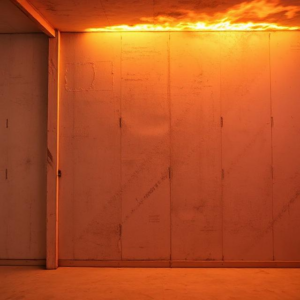Why Rebuild with Fire-Resistant Materials?
Besides emotional endurance, getting back on your feet after the devastation of a house fire also requires a lot of wise decision-making in terms of building back smarter and safer. Fire resistance is an important factor to consider for construction materials in your house. Considering that you live in wildfire or accident-paramount areas, you would want to avoid building a house that can so easily burn down. But how do you build a fireproof house?
Fireproofing is a way of reducing future fire risks and, thereby, protect the investment in your property. For sellers, selling homes highlighted for their fire-resistant features demonstrates an advanced mentality, attracting fire cash buyers in search of safer options.
How to Build a Fireproof House with the Right Materials
When considering how to build a fireproof house, prioritizing the fire resistance of structural elements is essential. Each part of your home, from the roof to the exterior walls, plays a role in minimizing the fire risk. Below, we break down different materials and their applications.
1. Start with a Fire-Resistant Roof
The roof is one of the weakest parts of a house, as it is generally most exposed to direct contact in a wildfire or ember attack. Some of the best options include metal roofing, clay tiles, and asphalt shingles rated for Class A fire resistance. Metal roofing, for example, is non-combustible and further offers the advantages of long life and reasonable weight for added fire safety. Concrete tile is yet another option that delivers both beauty and superior flame resistance.
2. Choose Exterior Walls That Defend Against Fire
The exterior walls are exposed to the weather, and fire is also a risk. Among the materials used, the best options for fire resistance include concrete, brick, and stucco. Out of all these materials, concrete acts as an excellent thermal insulator and would last for hours under tremendously high temperatures.
Fiber cement siding is another popular choice due to its durability and fire resistance. It replicates the look of wood but without the flammability. Also, ensure that the exterior wall assemblies are well-sealed to prevent flames from spreading to the interior.
3. Fire-Resistant Insulation
Many homeowners overlook the role of insulation in fire safety. Fire-resistant insulation materials such as fiberglass and mineral wool can mitigate flame spread risk within walls and ceilings.’ In the case of mineral wool, it is non-combustible and withstands high temperatures. When used in conjunction with fire-resistant drywall (Type X gypsum board), such walls present barriers to flame spread for extended periods.

4. Incorporate Fire-Resistant Windows
Windows may burst or break under high temperatures, letting a fire come to your house. Toughened, tempered, and wire-glass windows are more fire-resistant than ordinary glass. Double-glazed windows with an air atmosphere in between the panes reduce heat transfer, thereby decreasing breakage caused by sudden changes in temperature. Putting in metal frames instead of wooden ones goes a step further in securing one’s property from fire.
5. Select Heat-Resistant Flooring
When reconstructing fire-resistant homes, flooring materials tend to ignore or forget. Naturally fire resistant are ceramic tiles, stone, and concrete. Such materials are commonplace in kitchens and entryways but can be used throughout the house to maintain and unify a repetitive fire resistance design. Offers inflammable floor options outside such as untreated wood or carpet.
6. Don’t Forget About Fire-Resistant Doors
Go for the heavy-duty doors made of metal or fire-rated wood for protection of rooms. Fire-rated doors have special capabilities to withstand fire and heat for a specified period in order to give precious extra time for occupants to escape. They are important in garages and at any entrance leading to attached living areas.
Ensuring Long-Term Fire Safety
Rebuilding with fire-resistant materials is an essential step for safety, but there’s more to consider to maintain fire resilience. Here are a few additional steps to support your fireproofing efforts and ensure your home stays safe in the long term.
- Landscaping for Fire Safety
From fire prevention’s perspective, your yard is highly important. Keep an area around your house that is defensible, thereby eliminating dry vegetation, planting fire-resistant native plants, and pruning trees. Gravel paths and stone retaining walls serve as natural firebreaks in addition. - Install Sprinkler Systems
Fire suppression systems, like built-in sprinklers, offer an extra layer of safety by extinguishing flames in their early stages. Consider including these systems during the rebuilding process. - Regular Inspections and Maintenance
Fire safety is not something that is done once and then forgotten. Schedule regular inspections every year for your fireplace, chimney, gas lines, and electrical systems to catch possible fire hazards before they turn into serious risks. - Educate Occupants
Fire-resistant materials are just one part of the solution. Educate everyone in the household about fire safety protocols, evacuation plans, and early warning signs of fire hazards.
Selling Fire-Damaged Property? Highlight Fire Resistance
If you’re looking to sell your fire-damaged house, upgrading to fire-resistant materials will increase its marketability and appeal to safety-minded buyers. Emphasize these upgrades so that potential buyers will see the added protection your property now affords. Terms like “rebuilt using fireproof materials” or “fire-resistant redesign” can draw attention and reassure potential buyers about the home’s safety improvements.
Learning how to build a fireproof house begins with choosing the right materials that can withstand high temperatures and slow the spread of flames. From roofs and walls to insulation and windows, each decision during reconstruction plays a pivotal role in fire safety. By prioritizing fire resistance, homeowners can rebuild with confidence and create safer environments for their families.
Previous